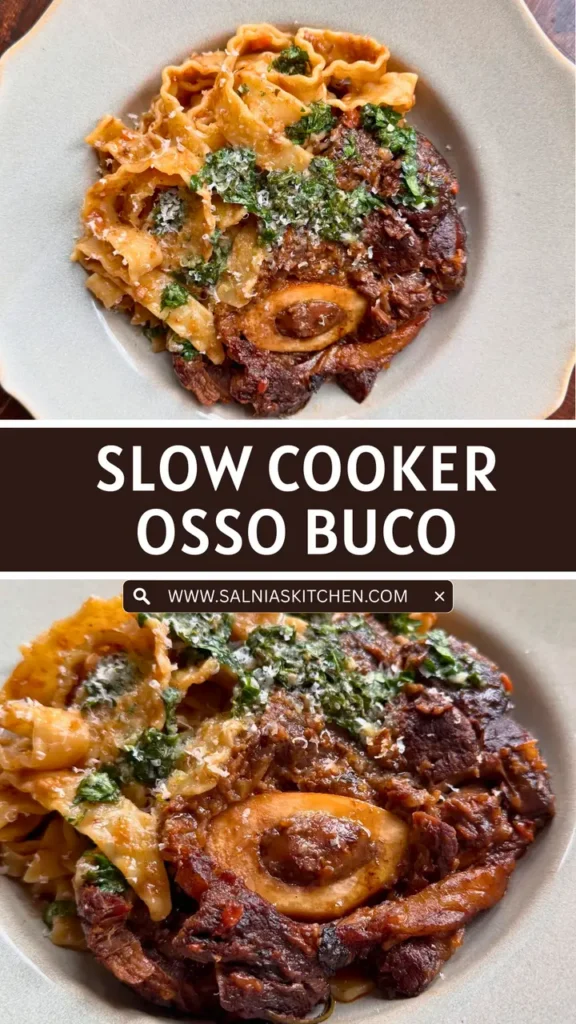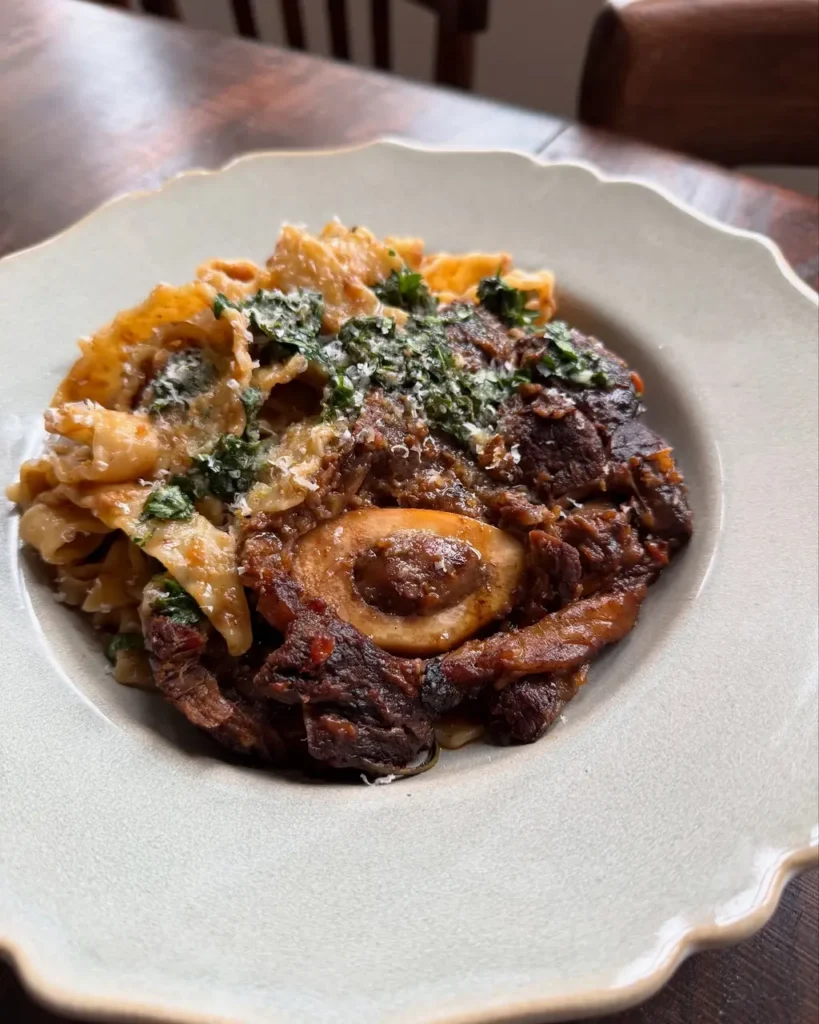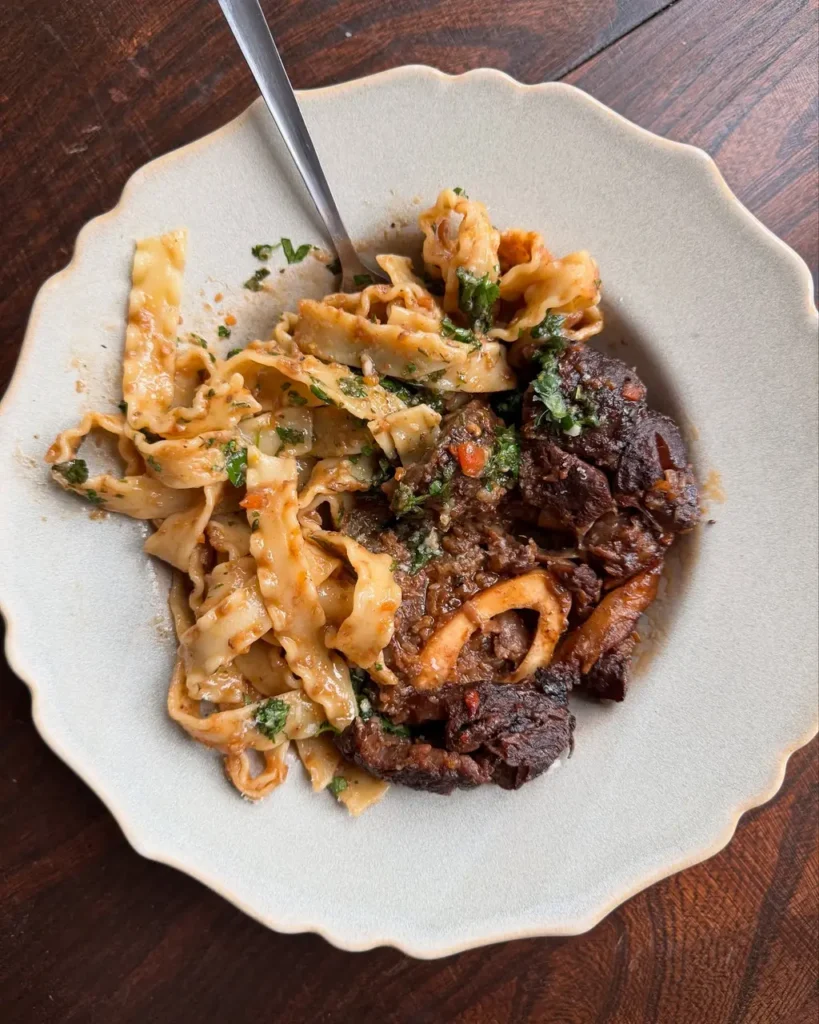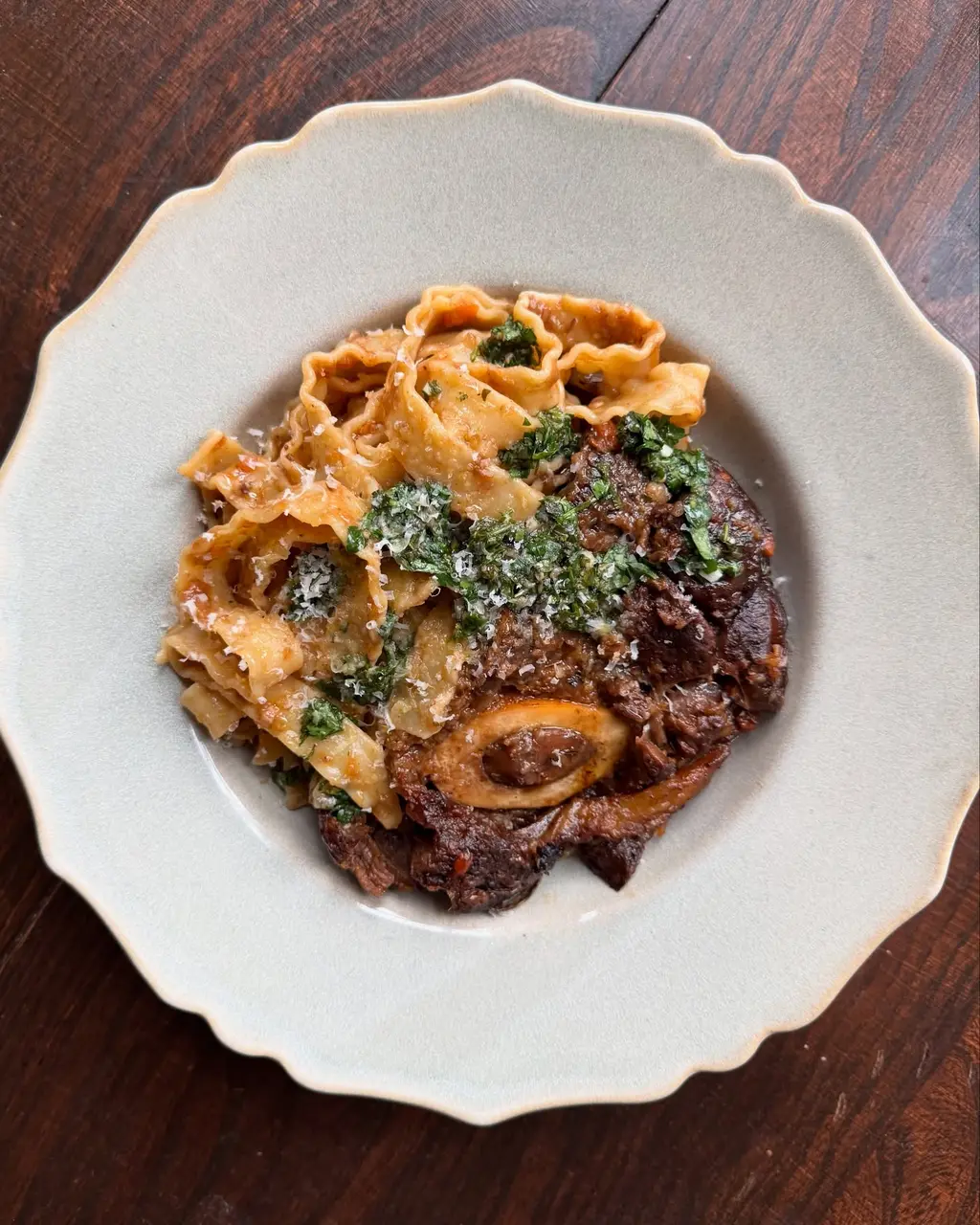Many slow-braised dishes promise depth of flavor and then only half deliver.
This slow-cooked beef osso buco truly delivers: melt-in-your-mouth meat, a glossy, savory braising jus, and a bright anchovy gremolata that lifts every forkful.
Why this version stands out

This take leans into deep, beefy umami while keeping the finish bright and lively.
The braise is built in stages to develop both color and complexity, then finished with a citrusy herb topping for contrast.
Ingredients you’ll need
Four generous shanks are the heart of the dish and should be treated like the stars they are.
Use beef osso buco (about 250g each) so each portion includes a marrow-centered bone.
A light dusting of plain flour seasons the exterior and helps form the roux of the braise.
A classic mirepoix of onion, carrot, and celery forms the aromatic backbone.
Garlic and tomato purée deepen the base, while beef stock and aromatics like rosemary and bay leaves carry the slow simmer.
Finish plates with freshly grated Parmesan and al dente pasta for soaking up the sauce.
For the bright finish, keep the gremolata simple: chopped flat-leaf parsley, finely minced anchovies, garlic, lemon zest, and a drizzle of extra virgin olive oil.
The secret to a perfect sear

Dry the shanks thoroughly before seasoning to encourage a deep brown crust.
A hot pan and patience are essential; resist the temptation to move the meat while it’s forming its crust.
Use a sturdy skillet and enough oil to coat the pan so the meat browns rather than steams.
A golden, caramelized surface not only adds color but creates hundreds of flavor compounds that dissolve into the braising liquid.
Building the braise in layers
After removing the browned shanks, remove excess fat and scrape up the fond from the pan.
Sweat the diced onion, carrot, celery, and minced garlic until they soften and begin to color.
Stir in the tomato purée and cook briefly so its sweetness mellows and it melds into the aromatic base.
Deglaze the pan with a splash of rich liquid, then return the meat to the pot with fresh stock and herbs.
Add rosemary and bay leaves for an herbal undercurrent that complements beef without overwhelming it.
A strip of lemon zest tucked into the braise provides a subtle lift that echoes the gremolata later.
Liquid choices and why they matter
This recipe uses a generous measure of beef stock to keep the braise concentrated and unctuous.
A small acidic element is included to balance richness and help extract flavor during the slow cook.
The right amount of liquid should almost cover the shanks but leave room for evaporation and concentration.
Too much liquid dilutes the sauce, while too little risks burning and uneven cooking.
Oven, stovetop, or slow cooker — choose your method

An oven set to low and steady heat is unbeatable for even, hands-off braising.
Arrange the casserole so the heat surrounds the shanks and maintain a gentle simmer.
On the stovetop, keep the lid slightly ajar and check the liquid occasionally to prevent sticking.
A slow cooker is a great hands-off option; transfer the seared meat and softened vegetables into the cooker and let it work its magic on low for several hours.
Whichever method you pick, the end goal is the same: the meat should fall away from the bone with a gentle pull.
When you can pierce the shank easily with a fork, the braise is done.
Finishing the sauce for pasta
Remove the shanks from the pot and skim off any excess fat for a clean finish.
Bring the braising liquid to a gentle boil and reduce until glossy and slightly thickened.
If you plan to serve the sauce with pasta, reserve some starchy pasta water to emulsify the sauce into a silky coating.
Toss the cooked pasta into a deep skillet with a ladle or two of braising liquid and a splash of pasta water to create a glossy, clingy sauce.
Shred a few pieces of meat into the pasta and tuck a marrow spoonful into the pan for extra richness.
Finish with generous grated Parmesan and a shower of gremolata for contrast.
Anchovy gremolata — how to make it sing
Chop the parsley finely so it disperses in every bite and doesn’t clump.
Mince the anchovies very small so they dissolve into the oil and lend savory depth rather than a dominant fishiness.
Grate or finely press the garlic for a smooth texture that blends into the gremolata.
Add lemon zest and a squeeze of juice to brighten the whole dish.
The final drizzle of extra virgin olive oil binds the herbs and aromatics together and makes the gremolata spoonable.
Spoon it over the finished shanks and pasta right at the table for the freshest impact.
Serving suggestions and pairings
This dish loves simple, rustic sides that soak up sauce — think long strands of pasta or creamy mash.
A crisp green salad on the side provides a refreshing counterpoint to the braise’s intensity.
A sprinkle of additional herbs or a few flakes of sea salt lifts the final plate.
For inspiration on light vegetable sides and quick salads, consider recipes like the Caprese Pasta Salad for warm-weather contrast.
Make-ahead, storage, and reheating

Osso buco often tastes even better the next day as the flavors continue to marry.
Cool completely and refrigerate in an airtight container for up to three days.
Reheat gently on the stovetop over low heat until steaming, adding a splash of stock if the sauce seems tight.
Freeze portions in freezer-safe containers for up to three months and thaw overnight in the fridge before reheating.
Helpful tips and troubleshooting
If the sauce is too thin after cooking, remove the shanks and reduce the liquid over a higher heat until it reaches a glossy, spoon-coating consistency.
If it’s too salty, add a peeled potato while finishing the sauce briefly to absorb excess salt and then discard it.
If the meat isn’t tender after the scheduled time, continue cooking and check every 20–30 minutes; tougher cuts vary and benefit from extra patience.
Rest the shanks for a few minutes before serving to let juices redistribute and make carving cleaner.
Variations to try
For a Mediterranean twist, fold in a handful of halved olives or capers into the sauce near the end for briny contrast.
Swap the gremolata herbs for a mix of parsley and mint for a fresher, brighter finish.
If you prefer a lighter plate, serve smaller shank portions over a bed of buttery polenta instead of pasta.
For a richer take, stir a knob of butter into the reduced sauce before tossing with pasta.
Where to find the best shanks
Buy from a butcher you trust and ask for evenly cut cross-sectional shanks so cooking times are consistent.
Well-marbled, high-quality meat makes a tangible difference in the final texture and flavor.
If you want to explore other comforting protein-forward mains, check a recipe for Herb-Roasted Chicken with Sweet Potatoes for a different Sunday roast idea.
For smaller bites and weeknight ease, dishes like Garlic Butter Shrimp Scampi offer quick, bright seafood that contrasts beautifully with braised meats.
Frequently Asked Questions (FAQ)
How long should I braise beef osso buco for maximum tenderness?
Plan on around three hours at low heat, but check for fork-tenderness and extend time as needed until the meat pulls away from the bone.
Can I prepare the gremolata in advance?
Yes, you can make the gremolata a day ahead and store it chilled, but add the lemon juice and olive oil shortly before serving for the freshest flavor.
Is anchovy gremolata fishy?
When finely chopped and mixed into olive oil, anchovies dissolve and add savory depth; they should enhance the dish without an overt fishy taste.
What pasta shape works best?
Long strands like tagliatelle or pappardelle are ideal because they twirl and catch the sauce, but any pasta you love will work well.
Can I convert this to a slow-cooker recipe?
Absolutely — after searing, transfer everything to the slow cooker and cook on low for 6–8 hours until tender.
Do I have to use marrow from the bone?
The marrow is a luxurious addition that enriches the sauce, but if you prefer not to use it, the dish will still be wonderfully flavorful.
Final thoughts
This slow-braised beef osso buco is a showstopper for weekends and special dinners, yet comforting enough for a slow Sunday supper.
The balance of deep, savory braise and the zesty anchovy gremolata makes each bite multidimensional and endlessly satisfying.
If you’re in the mood for something crispy and vegetable-forward alongside this rich main, try pairing it with Crispy Sweet Potato Kale Quinoa Fritters for texture contrast.
Or, for a quick family favorite to serve another night, the Garlic Butter Shrimp Scampi is a fast and elegant option.
Enjoy the process and the reward — there’s nothing quite like a pot-braised meal that fills the house with the smell of slow cooking and rewards you with tender, comforting food at the end.

Slow-Braised Beef Osso Buco with Zesty Anchovy Gremolata & Rustic Pasta
Ingredients
Method
- Pat the beef dry with kitchen paper. Mix the flour with salt and pepper, then lightly coat the osso buco, shaking off excess.
- Heat 2 tbsp olive oil in a large casserole. Sear the beef for 2–3 minutes on each side until well browned. Remove and set aside.
- Clear the pan of excess flour. Add another tbsp of olive oil, then cook onion, garlic, carrots, and celery for 5 minutes.
- Stir in the tomato purée and cook another minute, then pour in the white wine and simmer for 2 minutes.
- Add the beef stock, rosemary, bay leaves, lemon zest, and osso buco. Bring to a simmer, cover, and bake in the oven at 160°C (320°F) for 3 hours, stirring occasionally and adding water if needed.
- For the gremolata, mix parsley, rosemary, anchovies, garlic, lemon zest, lemon juice, and olive oil in a small bowl. Set aside.
- Serve the osso buco with pasta or mashed potatoes. Toss pasta with sauce and pasta water for a glossy finish.
- Top with gremolata and freshly grated Parmesan before serving.
Notes
- Check meat for fork-tenderness after 3 hours; extend cooking if needed.
- Gremolata can be made a day ahead, but add lemon juice and olive oil just before serving for freshness.


Leave a Reply